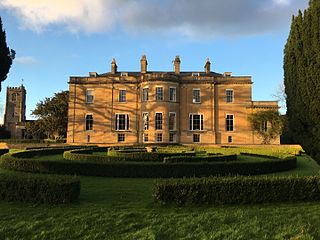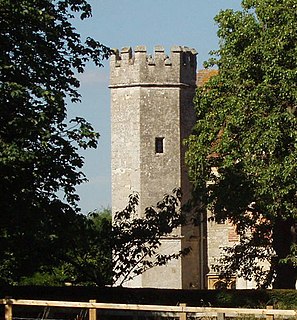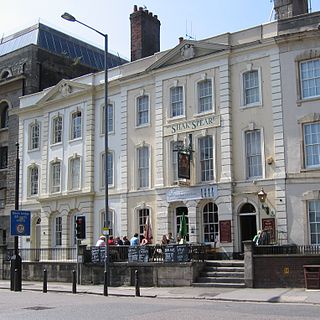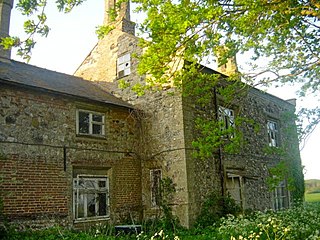
Calke Abbey is a Grade I listed country house near Ticknall, Derbyshire, England, in the care of the charitable National Trust.

Boscobel House is a Grade II* listed building in the parish of Boscobel in Shropshire. It has been, at various times, a farmhouse, a hunting lodge, and a holiday home; but it is most famous for its role in the escape of Charles II after the Battle of Worcester in 1651. Today it is managed by English Heritage.

Tabley House is an English country house in Tabley Inferior, some 3 kilometres (1.9 mi) to the west of the town of Knutsford, Cheshire. The house is recorded in the National Heritage List for England as a designated Grade I listed building. It was built between 1761 and 1769 for Sir Peter Byrne Leicester, to replace the nearby Tabley Old Hall, and was designed by John Carr. The Tabley House Collection exists as a permanent exhibition showcased by the University of Manchester.

Chillington Hall is a Georgian country house near Brewood, Staffordshire, England, four miles northwest of Wolverhampton. It is the residence of the Giffard family. The Grade I listed house was designed by Francis Smith in 1724 and John Soane in 1785. The park and lake were landscaped by Capability Brown.

Dinder House, is a Somerset estate with a small country house Grade II Regency listed building in the village of Dinder, in the civil parish of St Cuthbert Out in Somerset. Dinder House was formerly a manor house dating back to the 12th century, but the existing building was constructed between 1799 and 1801 by the Rev William Somerville on the original site. The estate remained as the seat of the Somerville family until the late twentieth century.

Hanbury Hall is a large 18th-century stately home standing in parkland at Hanbury, Worcestershire. The main range has two storeys and is built of red brick in the Queen Anne style. It is a Grade I listed building, and the associated Orangery and Long Gallery pavilion ranges are listed Grade II*. It is managed by the National Trust and is open to the public.

Notley Abbey was an Augustinian abbey founded in the 12th century near Long Crendon, Buckinghamshire, England. A team from Oxford excavated Notley Abbey in 1937, establishing a layout and timeline of the building's construction. The building has been visited by notable figures such as Henry V, and was owned by the celebrities Laurence Olivier and Vivien Leigh. Today, the remnants of the abbey are owned by the company Bijou Wedding Venues and are used to host weddings.

The Shakespeare is an historic pub in Prince Street, Bristol, England. Built in 1725 by the Bristol builder John Strahan as a pair of attached Georgian-style houses, it was converted into a pub in 1777 at which time it supplied refreshment to dock workers at the adjoining port. It has been a grade II* listed building since 1959.

Adlington Hall is a country house near Adlington, Cheshire. The oldest part of the existing building, the Great Hall, was constructed between 1480 and 1505; the east wing was added in 1581. The Legh family has lived in the hall and in previous buildings on the same site since the early 14th century. After the house was occupied by Parliamentary forces during the Civil War, changes were made to the north wing, including encasing the Great Hall in brick, inserting windows, and installing an organ in the Great Hall. In the 18th century the house was inherited by Charles Legh who organised a series of major changes. These included building a new west wing, which incorporated a ballroom, and a south wing with a large portico. It is possible that Charles Legh himself was the architect for these additions. He also played a large part in planning and designing the gardens, woodland and parkland, which included a number of buildings of various types, including a bridge known as the Chinese Bridge that carried a summerhouse.

Lytham Hall is an 18th-century Georgian country house in Lytham, Lancashire, 1 mile (1.6 km) from the centre of the town, in 78 acres (32 ha) of wooded parkland. It is recorded in the National Heritage List for England as a designated Grade I listed building, the only one in the Borough of Fylde.

Wroxall Abbey is a substantial Victorian mansion house situated at Wroxall, Warwickshire which was converted for use as a hotel, spa, wedding venue and conference centre. It is a Grade II listed building.

Milton is a village and civil parish about 3 miles (5 km) west of Didcot and a similar distance south of Abingdon. The 2011 Census recorded the parish's population as 1,290.

South Newington is a village and civil parish on the south bank of the River Swere in the Cotswold Hills in Oxfordshire, England, about 5 miles (8 km) southwest of Banbury. The 2011 Census recorded the parish's population as 285.

Sydenham is a village and civil parish about 3 miles (5 km) southeast of Thame in Oxfordshire. To the south the parish is bounded by the ancient Lower Icknield Way, and on its other sides largely by brooks that merge as Cuttle Brook, a tributary of the River Thame. The 2011 Census recorded the parish's population as 451.

Winnold House, formerly the Benedictine Priory of St Winwaloe, is a country house in the parish of Wereham in Norfolk, England. The house is constructed from the remaining fragments of a former Benedictine priory. The priory was founded in 1199 and was dissolved in 1321. It was demolished in 1539, and the surviving fragments were incorporated into a house sometime in the 17th century; it was rebuilt in the mid-19th century. It is a Grade II* listed building.

Goodnestone Park is a stately home and gardens in the southern part of the village of Goodnestone, Dover, Kent. It is approximately 7 miles (11 km) from Canterbury. The palladian house was built in 1704 by Brook Bridges, 1st Baronet. His grandson, Brook Bridges' daughter, Elizabeth, married Jane Austen's brother, and Austen visited them on the estate regularly. Goodnestone House is a Grade II* listed building, enlisted on 13 October 1952. The 15 acres (6.1 ha) gardens are considered to be amongst the finest in southeastern England.

Ellenborough Park Hotel is a country house hotel in Southam, about 2+1⁄2 miles (4.0 km) northeast of the centre of Cheltenham, Gloucestershire, England. It is a Grade II* listed building.

Cowick Hall is a 17th-century Georgian country house in the town of Snaith, located between the villages of East and West Cowick, in the East Riding of Yorkshire, England. The house is Grade I listed and several outbuildings on the estate are Grade II listed. Once home to the Viscounts Downe, today it serves as the corporate headquarters of chemical company Croda International.

Carnanton House is a Georgian country house in Mawgan-in-Pydar, Cornwall, England. It stands in a wooded estate at the head of the Lanherne valley adjacent to Newquay Airport and is a Grade II* listed building.

Wyfold Court is a country house at Rotherfield Peppard in south Oxfordshire. It is a Grade II* listed building. By the year 2000, the estate had been converted into apartments.





















